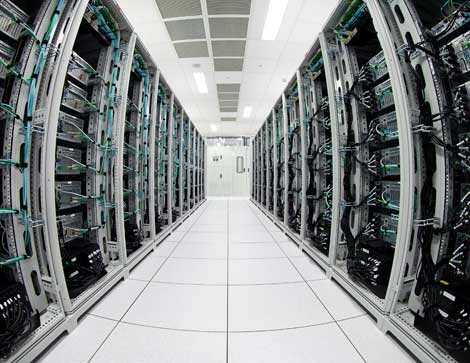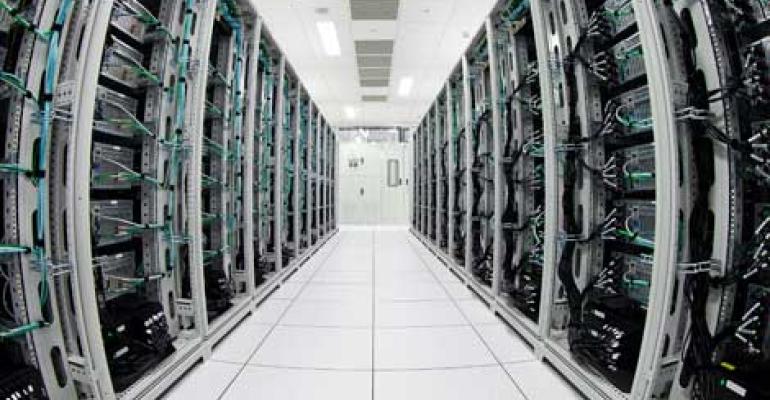
An example of the hot aisle in a Savvis data center in the London market. (Photo: Savvis)
The focus on the modern data center is only continuing to grow. As the business world moves to digitize even more infrastructure components, the data center will sit square in the middle of all of these new deployments. In fact, almost all of the new technologies and modern solutions which are coming out find the data center as their home. We can now call it “The Data Center of Everything.”
There are a lot more users coming online. These users are sharing more data and are requiring more services to be delivered to them. Data and services must stay highly available and very resilient. Furthermore, as more users fill the data center environment, high-density computing and highly efficiency systems are making their ways into the data center 2.0 infrastructures.
Big data center providers are sitting ahead of the curve for a few very specific reasons. They caught the cloud wave at the right time and deployed internal systems which were capable of handling the influx of data, users, and business which came to the data center for help.
Infrastructure Without Walls
As the data center of everything, organizations are directly looking to these new types of platforms to help them with many new types of business challenges. Companies of all sizes and verticals now see it as financially feasible and logical to move towards a data center model. And for good reason too. The data center has evolved from a brick and mortar shop to an infrastructure without walls. This means that these environments are logically connected to create massive resources pools and highly available data center platforms.
So, why is it good to be in the data center business?
- More data center services. Today’s data center environment isn’t there just to host servers and hardware. Data center providers are proactively building in services into their offering stack to entice new, modern customers. That means offering services around virtualization, cloud computing, disaster recover, and even hybrid data center extensions. All of these new services are evolving because more organizations are moving to a data center model. Infrastructure is becoming less expensive and the landscape is a lot more competitive. For many IT shops – it simply makes sense to move to a hosted data center model.
- More data to be managed. The average user may utilize three to four devices to access cloud-based resources. Whether this is a simple email or an entire desktop – these on-demand services have to be delivered from somewhere. Furthermore, all of these devices and connections transmit data and information. Data centers are becoming the hub for big data management and big data services. The highly distributed nature of big data has helped data center providers find yet another niche where they can help. By connecting their data centers together, providers can offer large networks where massive amounts of data can be analyzed and quantified. These types of services will only continue to grow for the data center model as big data continues to grow as an industry demand.
- More users coming to the cloud. The use of Internet services and wide area networking (WAN) has truly exploded. Now, we have everything from IPTV to everything being streamed via high-bandwidth resources. Furthermore, more bandwidth is becoming available for both the user and the organization. The data center of everything is also the home to the cloud. As the central hub for all connectivity and data distribution – the modern data center is tasked with hosting some of the most advanced technologies out there. Couple this with high-density computing, multi-tenancy storage, advanced networking technology, and top-down management solutions in the form of a data center operating system – and you will see the blueprint for the data center 2.0 platform.
- Global connectivity. The world has become more connected. The drive to conquer distance is driving the creation of the data center without walls. Modern technologies allow us to place more users, applications and workloads on a single blade. In turn, we are able to create large – logical network capable of global connectivity and failover. New types of load-balancing solutions allow for global traffic management and controls. This means that the data center is no longer one single entity. Rather, it is a node within a large cluster of interconnected data center environments. Basically, this is the formulation of the cloud and the globally connected networking environment.
The modern data center will only continue to evolve. Business drivers and demands are growing and more organizations are offloading services to the data center platform. Remember, the data center environment has become the heart of any organization as the central IT resource. These environments are being carefully managed, monitored and planned around for the future.
Conversations around pre-fabricated and modularized data centers are already growing rapidly. According to the 2012 Uptime Institute Survey, 41 percent of their respondents said that they are using traditional data center environments which are supplemented with pre-fabricated components. Another 19 percent said that they already have a data center made entirely out of pre-fabricated systems.
As reliance around the data center continues to grow, providers must stay ahead of the curve. This means understanding new demands and delivering data center services around those offerings. Whether those are new types of cloud platforms or better big data management systems – the data center will be the home of it all.





